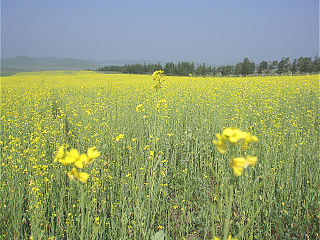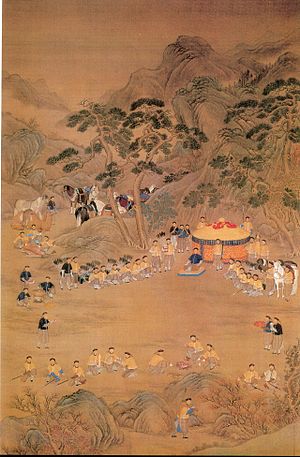
The Qing dynasty, officially the Great Qing, was a Manchu-led imperial dynasty of China and the last imperial dynasty in Chinese history. The dynasty, proclaimed in Shenyang in 1636, seized control of Beijing in 1644, which is considered the start of the dynasty's rule. The dynasty lasted until 1912, when it was overthrown in the Xinhai Revolution. In Chinese historiography, the Qing dynasty was preceded by the Ming dynasty and succeeded by the Republic of China. The multi-ethnic Qing dynasty assembled the territorial base for modern China. It was the largest imperial dynasty in the history of China and in 1790 the fourth-largest empire in world history in terms of territorial size. With over 426 million citizens in 1907, it was the most populous country in the world at the time.
The Manchus are a Tungusic East Asian ethnic group native to Manchuria in Northeast Asia. They are an officially recognized ethnic minority in China and the people from whom Manchuria derives its name. The Later Jin (1616–1636) and Qing (1636–1912) dynasties of China were established and ruled by the Manchus, who are descended from the Jurchen people who earlier established the Jin dynasty (1115–1234) in northern China. Manchus form the largest branch of the Tungusic peoples and are distributed throughout China, forming the fourth largest ethnic group in the country. They are found in 31 Chinese provincial regions. Among them, Liaoning has the largest population and Hebei, Heilongjiang, Jilin, Inner Mongolia and Beijing have over 100,000 Manchu residents. About half of the population live in Liaoning and one-fifth in Hebei. There are a number of Manchu autonomous counties in China, such as Xinbin, Xiuyan, Qinglong, Fengning, Yitong, Qingyuan, Weichang, Kuancheng, Benxi, Kuandian, Huanren, Fengcheng, Beizhen and over 300 Manchu towns and townships. Manchus are the largest minority group in China without an autonomous region.
The Eight Banners were administrative and military divisions under the Later Jin and Qing dynasties of China into which all Manchu households were placed. In war, the Eight Banners functioned as armies, but the banner system was also the basic organizational framework of all of Manchu society. Created in the early 17th century by Nurhaci, the banner armies played an instrumental role in his unification of the fragmented Jurchen people and in the Qing dynasty's conquest of the Ming dynasty.

The Jiaqing Emperor, also known by his temple name Emperor Renzong of Qing, personal name Yongyan, was the sixth emperor of the Qing dynasty and the fifth Qing emperor to rule over China proper. He was the 15th son of the Qianlong Emperor. During his reign, he prosecuted Heshen, the corrupt favorite of his father and attempted to restore order within the empire while curbing the smuggling of opium into China. Assessments of his reign are mixed, either seen as the "beginning of the end" of the Qing dynasty, or as a period of moderate reform that presaged the intellectual movements of the 1860s.

The Qianlong Emperor, also known by his temple name Emperor Gaozong of Qing, personal name Hongli, was the sixth emperor of the Qing dynasty and the fourth Qing emperor to rule over China proper. He reigned officially from 1735 until his abdication in 1796, but retained ultimate power subsequently until his death in 1799, making him one of the longest-reigning monarchs in history as well as one of the longest-lived.

Chengde, formerly known as Jehol and Rehe, is a prefecture-level city in Hebei province, situated about 225 kilometres (140 mi) northeast of Beijing. It is best known as the site of the Mountain Resort, a vast imperial garden and palace formerly used by the Qing emperors as summer residence. The permanent resident population is approximately 3,473,200 in 2017.

Heshen (Manchu: ᡥᡝᡧᡝᠨ, Möllendorff: Hešen; Chinese: 和珅; pinyin: Héshēn; Wade–Giles: Ho2-shen1; 1 July 1750 – 22 February 1799) of the Manchu Niohuru clan, was an official of the Qing dynasty favored by the Qianlong Emperor and called the most corrupt official in Chinese history. After the death of Qianlong, the Jiaqing Emperor confiscated Heshen's wealth and forced him to commit suicide. As an official, he acquired an estimated at 1.1 billion taels of silver, equal to roughly US$270 billion. Heshen is remembered as one of the richest men in history.

Chengde Mountain Resort is a large complex of imperial palaces and gardens situated in the Shuangqiao District of Chengde in northeastern Hebei province, northern China, about 225 kilometres (140 mi) northeast of China's capital Beijing. This resort was frequently used as a summer palace during the Qing dynasty. Because of its vast and rich collection of Chinese landscapes and architecture, Chengde Mountain Resort in many ways is a culmination of all the variety of gardens, pagodas, temples and palaces from various regions of China. In 1994, The Mountain Resort was awarded World Heritage Site status.

Shuai jiao is the term pertaining to the ancient jacket wrestling wushu style of Beijing, Tianjin and Baoding of Hebei Province in the North China Plain which was codified by Shan Pu Ying of the Nei Wu Fu. In modern usage it is also the general Mandarin Chinese term for any form of wrestling, both inside and outside China. As a generic name, it may be used to cover various styles of wrestling practiced in China in the form of a martial arts system or a sport. The art was introduced to Southern China in the Republican era after 1911.

The Macartney Embassy, also called the Macartney Mission, was the first British diplomatic mission to China, which took place in 1793. It is named for its leader, George Macartney, Great Britain's first envoy to China. The goals of the mission included the opening of new ports for British trade in China, the establishment of a permanent embassy in Beijing, the cession of a small island for British use along China's coast, and the relaxation of trade restrictions on British merchants in Guangzhou (Canton). Macartney's delegation met with the Qianlong Emperor, who rejected all of the British requests. Although the mission failed to achieve its official objectives, it was later noted for the extensive cultural, political, and geographical observations its participants recorded in China and brought back to Europe. It came to light in 1796 that a court official Heshen was stealing state funds and frustrated the mission.

Mongolia under Qing rule was the rule of the Manchu-led Qing dynasty of China over the Mongolian Plateau, including the four Outer Mongolian aimags and the six Inner Mongolian aimags from the 17th century to the end of the dynasty. The term "Mongolia" is used here in the broader historical sense, and includes an area much larger than the modern-day state of Mongolia. By the early 1630s Ligdan Khan saw much of his power weakened due to the disunity of the Mongol tribes. He was subsequently defeated by the Later Jin dynasty and died soon afterwards. His son Ejei handed the Yuan imperial seal over to Hong Taiji in 1635, thus ending the rule of the Northern Yuan dynasty in Inner Mongolia. However, the Khalkha Mongols in Outer Mongolia continued to rule until they were overrun by the Dzungar Khanate in 1690, and they submitted to the Qing dynasty in 1691.
A conquest dynasty in the history of China refers to a Chinese dynasty established by non-Han ethnicities which ruled parts or all of China proper, the traditional heartland of the Han people, and whose rulers may or may not have fully assimilated into the dominant Han culture.

Weichang Manchu and Mongol Autonomous County is a Manchu and Mongol autonomous county located in far northeastern Hebei province, China. It lies under the administration of Chengde City, and is the northernmost county of the province, bordering Inner Mongolia to the north. In terms of area, it is the largest county of Hebei, occupying an area of 9,058 km2 (3,497 sq mi), though, as it is located in mountainous terrain, it is rather sparsely populated, as of 2004, housing 520,000 people.
The history of the Qing dynasty began in the first half of the 17th century, when the Qing dynasty was established and became the last imperial dynasty of China, succeeding the Ming dynasty (1368–1644). The Manchu leader Hong Taiji renamed the Later Jin established by his father Nurhaci to "Great Qing" in 1636, sometimes referred to as the Predynastic Qing in historiography. By 1644 the Shunzhi Emperor and his prince regent seized control of the Ming capital Beijing, and the year 1644 is generally considered the start of the dynasty's rule. The Qing dynasty lasted until 1912, when Puyi abdicated the throne in response to the 1911 Revolution. As the final imperial dynasty in Chinese history, the Qing dynasty reached heights of power unlike any of the Chinese dynasties which preceded it, engaging in large-scale territorial expansion which ended with embarrassing defeat and humiliation to the foreign powers whom they believe to be inferior to them. The Qing dynasty's inability to successfully counter Western and Japanese imperialism ultimately led to its downfall, and the instability which emerged in China during the final years of the dynasty ultimately paved the way for the Warlord Era.
Shamanism was the dominant religion of the Jurchen people of northeast Asia and of their descendants, the Manchu people. As early as the Jin dynasty (1115–1234), the Jurchens conducted shamanic ceremonies at shrines called tangse. There were two kinds of shamans: those who entered in a trance and let themselves be possessed by the spirits, and those who conducted regular sacrifices to heaven, to a clan's ancestors, or to the clan's protective spirits.

The Dzungar–Qing Wars were a decades-long series of conflicts that pitted the Dzungar Khanate against the Qing dynasty and its Mongol vassals. Fighting took place over a wide swath of Inner Asia, from present-day central and eastern Mongolia to Tibet, Qinghai, and Xinjiang regions of present-day China. Qing victories ultimately led to the incorporation of Outer Mongolia, Tibet and Xinjiang into the Qing Empire that was to last until the fall of the dynasty in 1911–1912, and the genocide of much of the Dzungar population in the conquered areas.

The Qing dynasty (1644–1912) was established by conquest and maintained by armed force. The founding emperors personally organized and led the armies, and the continued cultural and political legitimacy of the dynasty depended on their ability to defend the country from invasion and expand its territory. Military institutions, leadership, and finance were fundamental to the dynasty's initial success and ultimate decay. The early military system centered on the Eight Banners, a hybrid institution that also played social, economic, and political roles.
The New Qing History is a historiographical school that gained prominence in the United States in the mid-1990s by offering a major revision of history of the Manchu-led Qing dynasty of China.

The Qing dynasty in Inner Asia was the expansion of the Qing dynasty's realm in Inner Asia in the 17th and the 18th century AD, including both Inner Mongolia and Outer Mongolia, both Manchuria and Outer Manchuria, Tibet, Qinghai and Xinjiang.



















